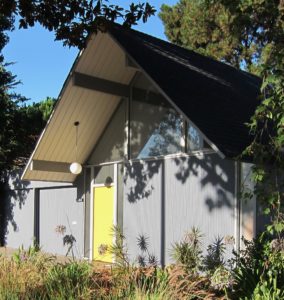
By Sharon Simonson
If Peter Thiel wants to leave Silicon Valley, I say, “Peter, bon voyage.” If you don’t know who Peter Thiel is, this story is for you. (Peter Thiel is a very rich Hollywood venture capitalist.) According to Peter, Silicon Valley is done. It has become an echo chamber talking itself into oblivion. Dear Universe, Peter Thiel and his ilk are distant satellites that orbit the real Earth that is Silicon Valley. HBO’s Silicon Valley and the myopic coverage of the national news media reinforce his tunnel vision. But technologists such as Mr. Thiel are not the majority. Life in Silicon Valley is much bigger, much richer, much more complex and interesting than Peter Thiel or the intricacies of Facebook, Google, and Apple.
Okay, okay, it’s true: tech companies are driving huge change across Silicon Valley. I’ve seen and lived and reported this story for nearly two decades. Their seemingly unquenchable desire for workers has fueled extraordinary population growth and a tremendous in-migration of people. Émigrés, almost entirely from Asia and especially India, are creating vibrant, unique communities crackling with intercontinental energy. Across our sunny vale, change swirls in dozens of different eddies.
But the newcomers arrive to a place where worldwide humanity has migrated for centuries, long before the nickname “Silicon Valley” stuck. Mr. Thiel and the tech industry constitute a veneer atop a deep human reality.
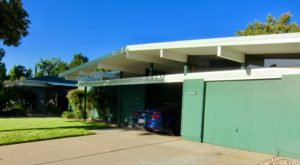
At a profound level, the Santa Clara Valley remains Hispanic. Its principal city, San José, is the oldest city in California, founded as a Spanish mission in 1777. There’s also Palo Alto (Tall Tree), Los Altos (The Heights), Los Gatos (The Cats), and Milpitas (Little Cornfields). Across San José’s East Side, on commercial signs, in neighborhoods like Sal Si Puedes, where Cesar Chavez spent formative years in the 1950s, Spanish remains la lengua preferida. On Sunday afternoons after Spanish Catholic mass, at restaurants and taquerías, Spanish-speaking sports broadcasters narrate soccer games for families and cowboy-hatted men. Televisions hang over modest chairs and tables where cans of Modelo accumulate and curvaceous waitresses deliver huevos con arroz y frijoles. A quarter of Silicon Valley’s population—not quite 500,000 people— identifies itself as Hispanic, almost entirely Mexican-American.
Over our Hispanic id have washed waves of immigrants and refugees, from Italy, Ireland, Germany, France, England, Japan, Korea, the Philippines, Vietnam, China, Nepal, India. Way before the first silicon chip, the population spike in San Francisco associated with the Gold Rush exploded local demand for food. In 1856, an immigrant from France, Louis Pellier, imported five hundred pounds of plants, seeds, and cuttings from his homeland, including the variety of plum whose cultivation became a multimillion dollar prune industry. Acres of plum, cherry, apricot, walnut, and other tree orchards blossomed white and pink en masse in the spring, stretching in tidy, irrigated rows across the valley. From 1920 to 1960, it was the world’s largest food-processing region. Today, orchards occupy remote corners, their gnarled trees grudgingly giving way.![]()
Since 1975, the year Saigon fell, the Vietnamese population has grown from nearly nothing to more than 130,000 people. In neighborhoods southeast of downtown San José that constitute Little Saigon, half the people say they are Vietnamese or Vietnamese American; many speak only Vietnamese. The food court in the Lion Plaza shopping center at Tully and King roads serves Vietnamese food only. Services from tax preparation to legal advice are available in Vietnamese.
The city of Fremont has become “the place where tech-working Indians are made,” stand-up comic, Mumbai native and Fremont resident Samson Koletkar said. Koletkar came to Silicon Valley eighteen years ago to work in tech. Four years ago, he co-founded Desi Comedy Fest to feature South Asian comedians. A desi is an Indian-born person living outside of India. (Immigrant joke: an “ABCD” is an American Born Confused Desi.)
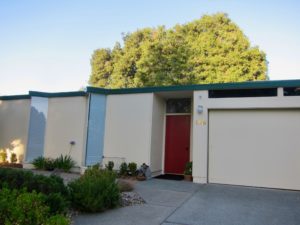
Koletkar believes stand-up is a quintessential American art. Doing it has blown his mind: “When we talk about our stories and struggles, they are not unique. They are universal. That’s how stand-up brings people together. I had perceptions of people that were so wrong. I have a transgender friend. If you told me fifteen years ago that my kid would have a play-date with a transgender’s child, I would have said, ‘Stop doing drugs.’ It’s amazing how all of these fears and preconceptions have just disappeared.”
Forty percent of the people who live in Silicon Valley—717,600 residents—were born outside the United States. That’s nearly three times the national rate and one and a half times the rate in California. From 2009 to 2016, more than 60 percent of Silicon Valley’s population increase came from people immigrating to the United States. The greatest threat to Silicon Valley’s technology industries is not our housing prices or our endemic homelessness or our transportation nightmare. It’s “the prospect of the immigration nozzle being screwed shut,” says Stanford University author and historian Leslie Berlin. “No immigrants, no Silicon Valley.”
We are—like San Francisco, Los Angeles, New York, Houston—a global metropolis. We have what Yale University sociologist Elijah Anderson calls a “cosmopolitan canopy,” urban public squares where people from a wide spectrum of socioeconomic, educational, racial, and ethnic backgrounds interact with grace and civility.
Media impressions to the contrary, technologists are not Silicon Valley’s highest paid residents. Anesthesiologists earn the most: almost $25,000 a month on average. They’re followed by obstetricians/gynecologists, surgeons, psychiatrists, physicians, chief executives, nurse anesthetists, internists, marketing managers, and lawyers, in that order. The first technology job on the state’s ranking of Silicon Valley occupations by median hourly wage is “computers and information systems manager,” at number eleven. On average, they earn not quite $17,000 a month. Fast-food cooks earn about $2,000 a month, card room dealers slightly less.
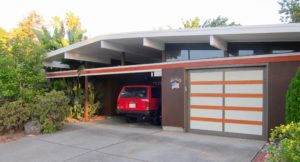
When I say Silicon Valley, I mean The South Bay. Santa Clara County. The Valley of Heart’s Delight, a reference to our historic bountiful food production. I mean the 1,300 square miles that wrap the south end of the San Francisco Bay. That embrace a large central plain flanked on both sides by round—sometimes dewy-emerald, sometimes burnt-yellow—foothills. I mean the forested peaks of the coastal mountains that frame the foothills. I mean the valley’s southern reaches where horses and cows graze on a pastoral landscape and vineyards ebb and flow delicately across foothills. The counties to Silicon Valley’s north, San Mateo and San Francisco, would love to appropriate our worldwide name. They are not Silicon Valley.
Elite urban planners and architectural thinkers like New Yorker writer Lewis Mumford and his San Francisco acolytes like to sniff at the Silicon Valley built-environment. Mumford’s 1961 book The City in History, which earned a National Book Award, cited San José and surrounding cities as exemplars of the worst formless, post-war suburban development. Thank you for your opinion, Lewis.
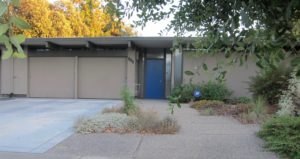
Today, from atop the foothills in Santa Teresa County Park, the valley’s sea of mid-century homes and neighborhoods has attained integrity, something approaching charm. A canopy of trees decorate streets that curve around grassy city parks and suburban high schools. Builders mass-produced housing for the first time in American history after World War II. As federal defense spending created tens of thousands of jobs in Silicon Valley and California, ten million American veterans came home. California drew more new population than any other state. In Silicon Valley, in the three decades from 1950 to 1979, home builders à la Levitt carved land and constructed an average of nearly 13,000 homes a year—approximately 370,000 from 1950 to 1979. That’s still more than half of the valley’s total housing stock. Nearly all of the homes were single-family detached on small lots, less than an acre. Vast numbers of them were considered California ranch homes or some derivation thereof.
No question, many of those post-war ranch houses, built fast and cheap, have aged more poorly than an alcoholic grandma. But to dismiss the ranch house as another mass-produced American monstrosity is to miss its eloquent expression of California history and identity. A sixth-generation California native, Cliff May conceived the ranch house in the 1930s. Born in 1908 in San Diego, he spent summers at his aunt’s ranch and farm, living in what was literally a ranch house. In his first tract-home subdivision, each house embodied “the romantic charm of early-day California Ranch life,” according to May’s marketing.![]()
With its signature U- or L-shaped configuration embracing an open-air rear courtyard onto which nearly all rooms looked or led, the ranch home exploits California’s greatest asset, its inimitable climate. The home’s physicality embodies the state’s cultural mythology of easy living, intellectual and personal openness, fluidity and flexibility, an eschewing of stiffness and too much stuff. In the late 1940s, Jim Morrison, the child, lived for two years in a small rancher at 476 Yosemite Avenue in Mountain View. Steve Jobs’s 1,800 square-foot childhood home deep in the heart of Silicon Valley is a quaint little rancher set within a sea of like ranchers. The state in its historic designation for the Jobs house says, “the neighborhood…fostered innovation and creativity.” Jobs, Steve Wozniak, Jobs’s stepsister, Patricia, and a couple of other people assembled the first Apple computers in its garage in 1976.
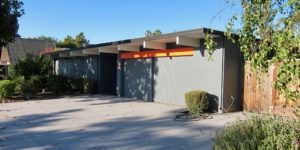
In Silicon Valley, the ranch house inevitably gave rise to the pointy-headed Eichler home, an angular, windowy expression of modernist post-war America. A child of German-Jewish immigrants and a devotee of Frank Lloyd Wright, Joseph Eichler was extremely unusual among mass-production post-war American home builders: he had an architect design his houses. Another anomaly: Eichler sold homes to non-whites, unlike virtually every builder in the Bay Area and nationwide, a discrimination endorsed at the time by our federal government. Eichler built about 11,000 homes, mostly in the Bay Area, three thousand in Palo Alto alone. Two Palo Alto Eichler home communities are listed on the National Register of Historic Places.
Now, again, Silicon Valley’s population growth—driven by immigration, faster than the state’s and nation’s—is fueling a building boom, more accurately in many cases, a re-building boom, the biggest building boom in its history. Modern landmarks of a stature never seen are rising. An open-air 18,000-seat soccer stadium—soccer is the most popular sport in the world—has replaced a moldering Cold War-era tank-manufacturing plant adjacent to the San José airport. The (heavily indebted) airport is the recent beneficiary of more than $1 billion in public investment. That doesn’t include the $82 million private air terminal where Google co-founders Sergey Brin and Larry Page keep their jets. Downtown San José has a new, Richard Meier-designed City Hall. Corporations including Apple, Google, Samsung, and Nvidia for the first time have undertaken to create architecturally significant headquarters designed by architects of renown. Whatever you think about American football and massive arenas, the $1 billion Levi’s Stadium in Santa Clara is clearly a wondrous cultural marker.![]()
Redevelopment along El Camino Real, Silicon Valley’s historic, commercial north-south spine, is transforming a veritable wasteland. Twenty years ago, despite its royal lineage and even as the dot-com boom raged, saggy, fifty-year-old motels, retail strip centers coated with crumbling stucco, windowless bars with names like “The Alibi,” greasy fast-food joints, and schleppy 1980s Midas repair shops persisted along the length of El Camino. Inexorably, starting in Palo Alto and moving south, sleek new office buildings, condominium towers, and modern apartment blocks with modular, Mondrian-style paint jobs and tasteful, upscale lobbies are replacing the junk. The vast seas of surface parking that mar America’s suburban landscapes are disappearing: the land is too valuable for that.
Not all of the redevelopment is progressive. For all the innovation of its products and the visual novelty and sheer scale of its new Norman Foster-designed campus, the Apple ring represents a corporate throwback. Heavily secured, inaccessible to the public, it ignores all modern theory about the most productive, livable urban environments. It is in no way a part of the “urban fabric” and says everything about Apple’s attitudes towards the larger community.
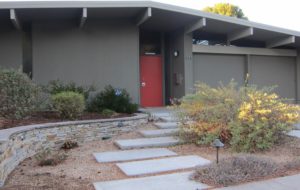
“It’s kinda creepy,” my 21-year-old son said as we drove past the huge structure in the summer twilight one evening before it opened.
“Yeah. It looks like the Death Star,” I said.
The building dwarfs the surrounding neighborhoods where modest ranch houses fill small lots. It begs to be made symbolic: of power, with its vast size; of paranoia, with its perimeter fencing and determined apartness. But no one could doubt it as a landmark. From the Upper High Meadow Trail in the Rancho San Antonio Preserve, the enormous ring presents as a smooth, flat, black circle, topping out at the same height as the surrounding trees but an embodiment of the manmade future, ready at any moment to lift slowly, propelled by fiery jets, into the stratosphere.
Land—and how it will be used—has become a bloody battlefield in Silicon Valley. New-home production—what the community will allow to be created— has plummeted since the 1980s to an average of about 4,000 new homes a year, not nearly enough to outrun demand or even to meet it, or prices would not be rising as they are. If you don’t own a home—and sometimes even when you do—you face constant threat of eviction. Rows of shabby tents hang from the dirt inclines below freeway overpasses and along the banks of city-bound creeks. Recently, as I left downtown San José after dark, the police had invaded a homeless camp with a half-dozen bubble tents set precariously close to a freeway on-ramp. A man, evidently living there, stood holding a brown and white puppy under his left arm, waiting, looking ahead at nothing as the officers riffled his belongings.![]()
Realtors bombard my mailbox daily with expensive, glossy color brochures, some pages long, trolling for a listing and a guaranteed paycheck. The median price of a Santa Clara County home sold in 2016 was $1.02 million. A five percent commission on $1 million is $50,000; on $2 million, it’s $100,000—real money.
“I hate money,” my husband said to me recently.
I hate what money makes us become.
The driver of a shuttle taking me to Mineta San José International Airport told me he was from Sudan.
“How do you like Silicon Valley?” I asked.
“In Sudan,” he said, “I had a good job, a good life, but I had no freedom. Here, I have complete freedom, but all I do is work.”
An old person is practically a novelty in Silicon Valley. People sell their homes and depart with their windfalls. Or they just depart. I don’t think I’ve ever heard someone say, “I think I’m going to retire to Silicon Valley.”
When we aren’t working to make money, my husband and I mountain bike and hike in the vast public land preserves at the top of the Santa Cruz Mountains. Winter rains transform the mountain valleys into emerald wonderlands overhung by mossy trees and cut by itinerant streams jumping rocky cataracts. The Christmas we got our bikes, our enthusiasm conquered cold, rain, and rocky trails. Ice crystals hung from my husband’s black beard. The fog rolled fast against us and through the wheel spokes—so milky-thick that I worried we’d ride right off the side of the mountain.![]()
But a scary number of the trees that I love are dying. Drought, which has killed 129 million trees across California since 2010, kills two million more a month. Dead trees pock my Silicon Valley neighborhood, the street medians, the flanks of Interstate 280 up the Peninsula to San Francisco, and vast swaths of the Sierra Nevada. I wonder what John Muir would say. He devoted the longest chapter, nearly a quarter of the pages in his 1894 landmark book Mountains of California, to “The Forests.” I scan the horizon every morning, searching for the rain clouds that roll like cotton-ball fog over the mountains that separate me from the sea.
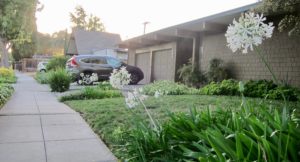
More than ever, weather is creating a sense of apocalypse. In fall 2017, after months without rain, the largest firefighting force in state history responded, some traveling from as far as Australia, to extinguish a wildfire that was killing people and ravaging homes and vineyards north of San Francisco, seventy-five miles away. Two months later the Thomas Fire, the worst wildfire in state history, would burn nearly 300,000 acres, including homes and buildings in the city of Ventura. By some bad luck, my husband was working nearby. To reassure me that the fire was far away, he sent a photo taken from his office window. It featured a gray smoke-funnel rising hundreds of feet into the air above the city, filling two-thirds of the horizon. Not reassuring. When an earthquake’s sickening ground-rumble shook me awake at 2:30 a.m. a month later, hot tears wet my pillow. Was the Earth wobbling in its orbit to cause this successive display of nature’s power, and maybe, anger? Centered eight miles below the East Bay city of Berkeley, the quake exacted little property damage and passed in the local press with a day’s notice. But the Earth’s battering left me unsteady. Then the Montecito mudslides killed twenty.
We find ourselves entering a new era in Silicon Valley—our minds expanded by broader and deeper connection to people, cultures, and ideas worldwide, our bodies buffeted by a rapidly urbanizing city, transmogrifying around us, an expression of our collective will. At the same time, each of our individual identities is evolving in a purely singular fashion, wrought by forces unique to our moment and place. Each of us is adjusting to fit and grow with and into our collective expression. Above it all, we are witnessing what seems accelerating change in the stupendous natural environment that has lured people to the region for thousands of years.
The built environment articulates the life of the people who create and live in it, architectural historian Mumford tells us in The City in History: “The ability to transmit in symbolic forms and human patterns a representative portion of a culture is the great mark of the city: this is the condition for encouraging the fullest expression of human capacities and potentialities, even in the rural and primitive areas beyond.” So, even as cities telegraph who we are, they catalyze who we will be.
I, for one, can’t wait to be the new me.
“Rebirth in Silicon Valley” originally appeared in Reed Magazine, the literary journal of San José State University. It is reprinted here with Reed’s full permission.
![]()